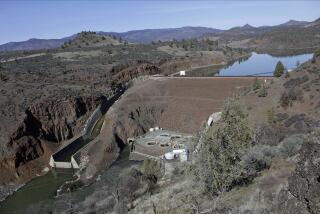Iraqi Dam May Inundate Ancient Assyrian Site
- Share via
An Iraqi dam under construction on the Tigris River threatens to submerge the remains of the spiritual capital of the ancient Assyrian empire in an act that archeologists liken to flooding the Vatican.
Much of the city of Ashur, which thrived for more than 1,000 years until the Babylonians razed it in 614 B.C., could vanish under a lake to be created by the Makhoul dam, U.S. and European archeologists said.
More than 60 outlying historical sites also are threatened.
Ashur, or Assur, was of such importance that it lent its name to the Assyrian civilization.
“Losing it would be like, I guess you could say, losing the Vatican,” said Mark Altaweel, a Baghdad-born doctoral student at the University of Chicago who is using satellite data to study the ruins-rich region surrounding Ashur.
Ashur sits on a bluff about 130 feet above the Tigris between Mosul and Baghdad. Most of the city, including the lower portions most vulnerable to flooding, have never been explored in the century since the first archeological teams visited the site.
The city was the spiritual center and trading hub of one of the world’s first great empires that, at its peak, stretched from Egypt to Iran and into Turkey.
Estimates of how much of the city would be submerged vary from half to the entire site.
The dam, slated for completion by 2007, is the result of economic sanctions imposed on Iraq after its 1990 invasion of Kuwait, said John Malcolm Russell of the Massachusetts College of Art in Boston.
Iraq has been pushing toward greater self-sufficiency in food production, which has led to development of massive irrigation projects of which the dam is part, said Russell, an art historian and expert in ancient Assyria.
In the past, dam-building projects threatened other archeological sites in the Middle East. Typically, each case sparked an international salvage effort, most notably in Egypt, where the great temple of Ramses II and several other temples and statues were moved to spare them from the lake created by the Aswan dam on the Nile.
The United Nations Educational, Scientific and Cultural Organization is now assisting Iraq in assessing the Makhoul dam’s impact on Ashur and what, if any, measures can be taken to prevent its destruction, said Giovanni Boccardi, chief of the U.N. organization’s Arab states unit. A report detailing its recommendations has not yet been made public.
Iraq has also submitted a draft nomination to UNESCO to have Ashur named a world heritage site, which would add it to 763 locations around the world, including China’s Great Wall and the ruins of ancient Pompeii. But a plan to protect and manage the site must be devised before that status can be granted.
“The possibility for the site to be inscribed on the list will obviously depend on our capacity to identify ways and means of ensuring the conservation of the outstanding universal value of Ashur,” Boccardi said.
In Iraq, antiquities officials dispatched 10 teams of archeologists to the Ashur region, said Peter Miglus of the University of Heidelberg in Germany, who last dug at the site in 2001. Since then, no international teams have been asked back.
“There has been no invitation issued, as they euphemistically call it, to rescue these sites,” Russell said.
Overall, the situation for archeology is not much better elsewhere in Iraq since the end of the Gulf War.
Thousands of looted objects, including Assyrian reliefs purloined from museums and storehouses at archeological sites, have appeared for sale at auction and on the Web.
“I have become so depressed by the flow I have stopped looking at eBay,” Russell said.
Archeologists, including members of the Archeological Institute of America, fear that the situation will worsen if there is war.
“It will be a mess if we go in again,” said Samuel Paley, professor of classics at the State University of New York, Buffalo. “Who knows what will happen? You balance what we consider the political needs of today with the heritage of antiquity. What comes out on top?”
More to Read
Sign up for Essential California
The most important California stories and recommendations in your inbox every morning.
You may occasionally receive promotional content from the Los Angeles Times.













